What Lies Beneath: Arizona’s Precious Gems and Minerals
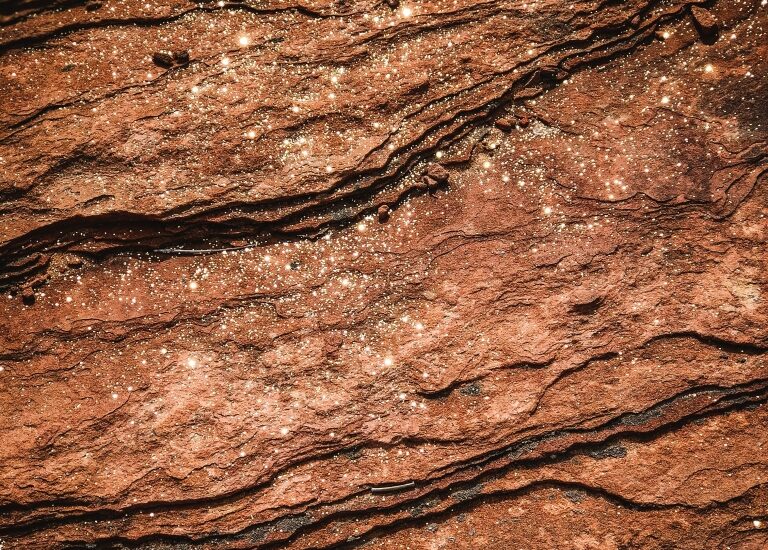
Writer Shannon Severson
Hidden beneath the red dirt, rugged boulders and scrubland of creosote and mesquite, are mineral and gem deposits to be discovered by the most intrepid seekers. The story of these precious resources are part of the history and character of Arizona, responsible for the rise, fall and sustenance of towns, industries and natural resources. Many are also prized for their perceived healing properties.
Gem mining in our state dates back to the mid-19th century. The earliest settlers came in search of gold and silver, but copper and gemstones soon became the dominant quest for pick, axe and drill in the early 1900s.
The notable gems detailed here are peridot, amethyst, turquoise and ant hill garnet, but obsidian, fire agate and quartz crystal are also notable for their proliferation and cultural significance.



King Copper
As “The Copper State” is but one moniker of Arizona — and one of the five Cs that school children still learn about as the industries that drove our early economy — copper remains a vital resource. It was first mined by the Hohokam, Sinagua and Anasazi Native American tribes who used the malleable mineral to fashion jewelry and tools and use for trade. In 1540, near what is now Nogales, the Spanish established the first recorded copper mine in Arizona.
By the early 20th century, mineral patents were granted to mining companies and large operations were established. The Phelps Dodge Corporation became a driving force in the state’s copper industry and developed enormous pit mining operations in Bisbee, Morenci and Bagdad.
This ultimately led to the development of modern mining technology and techniques, which can still be observed at the ASARCO Mission mine near Sahuarita. It’s the only public tour of a working copper mine in the area and also has a free exhibit center, video theater and cactus garden. A one-hour bus tour takes visitors to the open pit mine’s rim and gives them a glimpse inside the grinding mill building.
The Arizona Mining Association is an excellent resource for mine tours, museums and mining exhibits. Copper is still a very much in-demand mineral and is vital to the state’s economy as Arizona remains the top producer of copper in the United States.
The city of Bisbee is the spot to see where a mine’s boom and bust formed a town that is now a prime tourist destination. The Copper Queen Mine (1880–1975) can still be toured. In sum total, that mine produced approximately 8 billion pounds of copper, along with smaller amounts of gold, silver, zinc and lead, among other minerals.
The Bisbee Mining and Historical Museum offers a comprehensive overview, created in concert with the Smithsonian museums.
azmining.com
copperqueenmine.com
bisbeemuseum.org
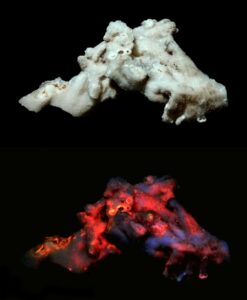


Castle Wonders
Fluorescent and phosphorescent minerals were probably indistinguishable to early miners. But with blacklight, the colors are revealed. How does it do that?
According to Castle Dome Museum CEO Allen Armstrong, it all starts with small impurities in the rocks that serve as activators for the collision of protons and electrons; calcite, fluorite, scheelite, willemite, barite, hydrozincite, aragonite and selenite are activated when hit with black light. The proton collisions in this former silver galena mine continue for up to an hour after the lights go out.
“It looks like a starry night,” Armstrong says of the Hull Mine’s massive 50-foot-high chamber. “It’s like you’re in the Milky Way. Even the sand you stand on is glowing. [Ours is] the most colorful wall on the planet; like a big kaleidoscope that reaches up as far as you can see.”
Founded by Arizona’s first citizen, Colonel Jacob Snively, and William Ehrenbergy in 1864, Castle Dome City and mining district lies just outside of Yuma at the base of Castle Dome Mountain. It was first used to mine gold and silver galena and spans more than seven miles, with 300 patented mines and a full ghost town that was home to 4,000 people back in 1878.
The town holds 80 buildings — including five saloons, a church, banks, mercantiles, a shower house and an operational stamp mill that was used to crush thousand-pound rocks. During World War II, 9 million pounds of silver galena was pulled out by the Holmes brothers and the area was mined until the late 1970s when falling silver prices made the endeavor unprofitable. The entire place is a piece of national history and a geological marvel.
“A lot of people go into the mine and say it’s the most beautiful thing they’ve ever seen,” Armstrong says of the glowing chamber 100 vertical feet below ground, discovered in 2017. “There are only three walls like this in the world but the others have only three colors. It’s a mind-blower. These are minerals they had no use for at the time and there are rare earth minerals they didn’t know about.
“The mine is big enough to drive through and even has a blacksmith shop inside. We paved it with 250 yards of concrete and put decking in a few places. It’s 75 degrees inside with good airflow. The Occupational Safety and Health Administration called it the safest mine they’ve ever been in.
“Items we have found inside are in perfect condition. We even found ‘denim gold’ — a 150-year-old pair of Levi’s 201s with no left pocket and no belt loops. There was even a little knife with two blades inside a pocket.”
Armstrong says there is so much left intact that the sights above ground are a treasure trove in themselves. He, his wife Stephanie and a dedicated group of volunteers have painstakingly restored the site, created sustainable power infrastructure and shaped it into a place for the public to enjoy. The CEO adds that it’s impossible to see it all in one day.
“The mining and trails from the Spanish Conquistadors in 1590 are still here,” he notes. “They’ve filmed movies here; it’s the Yosemite of the desert with beautiful trees and landscape. Everybody loves it. You can’t have a museum on 350 acres anymore. It’s not profitable, but it’s something people long for. It’s not commercialized.”
Small group tours of the Hull Mine transport visitors along two miles of old trails dotted with large pieces of metal art and sculpture. Once inside, an underground mine vehicle takes visitors down into the mine and back in time to see the burst of glowing phosphorescent colors and to view an existing silver vein, desperado hideout and blacksmith shop.
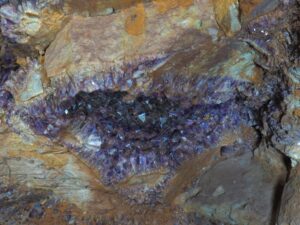


Jewel In The Crown
Amethyst is a purple, quartz-based gemstone prized by royalty for its rich violet hue. It is believed that in the 18th century, Spanish settlers discovered what is now the Four Peaks Mine in the Mazatzal Mountains.
The amethyst that comes from within the mine is prized throughout the world for its deep color and flash of “Siberian red,” so called because the only other place in the world where these same characteristics can be found is in the Siberian mines of Russia’s Ural mountain range. It’s the high iron content, manganese and magnesium along with extreme heat that produces the highly prized gemstone color.
Susan Emberley, the general manager of Four Peaks Mining Company in Scottsdale, says the store opened to create a brand for the Four Peaks line of jewelry.
“It requires one ton of mined material to produce two handfuls of gemstones,” Emberley says. “The crystals that come out of the mine are transported by helicopter to be tumbled in Tempe. By the time it is sold in our store, it has traveled around the world.”
Promising pieces that emerge from the tumbling process are sent to Indonesia to be cut to specification by skilled craftspeople. Those cut stones then travel to New Jersey where the owner of the mine sets them himself in sterling silver, marries the gems with designated settings and returns them to Indonesia for completion. The store also sells Four Peaks amethyst set in yellow, rose and white gold.
Emberley says the yellow gold settings are very popular because they really show off the flash of Siberian red. Cleaned, unadulterated crystals can also be purchased by collectors who want to polish and cut the stones themselves.
The store carries an enormous array of gems, minerals and rocks, including metaphysical healing crystals each labeled with their purpose. While Four Peaks Mining Company prides itself on carrying rocks and minerals from Arizona — fluorite from the Lucky Blue Mine; chrysocolla, a decorative secondary copper mineral often mistaken for turquoise, from the Rowley Mine; and turquoise from the Kingman and Sleeping Beauty mines — Emberley says there are gems, jewelry and geological specimens from all over the world.
“We also carry wulfenite, which is extremely rare,” she says. “It was named our state mineral in 2017. As miners dig out huge boulders of chrysocolla, they will come across a vein of wulfenite and it is usually damaged in the excavation process, but it’s bright orange and highly sought-after.”
There is even a replica of the mine within the store. Inside, young rockhounds can find and identify up to 30 minerals embedded in the walls and ceilings. In the adjacent blacklight room, naturally fluorescent minerals can be observed. The store is like a museum where one can learn, explore and then actually purchase pieces to take home for personal collection.
“We try to appeal to all ages,” Emberley says. “You can break open geodes and children can buy bags of polished stones. Lots of young kids are junior geologists and they are really into rocks and minerals. They can come in and see specimens from all over the world tagged with names and origins.”
To really get up close and personal with Four Peaks amethyst, the company offers public and private mine tours with access via helicopter beginning in September, weather permitting. Fires and the rock slides that resulted from a total lack of vegetation ravaged the area and destroyed the mine in 2021, but the mining company has been rebuilding ever since and is back to offering exclusive tours by reservation.
“It’s a once-in-a-lifetime experience and the private tours have really blossomed in this past year,” Emberley says.
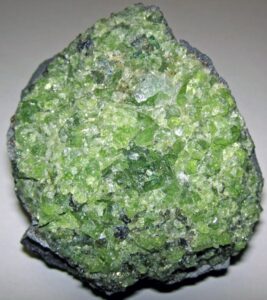


Glowing Green
Peridot — the traditional birthstone for August and the precious gem-quality version of olivine — varies in color from pale green to deeper olive. The only known location where this gem can be found in the United States is at the San Carlos Apache Reservation near Globe.
Like amethyst, peridot also consists of magnesium and iron. The green hue depends on the amount of chromium or nickel and so ranges from yellowish green to deep green. The higher the iron content, the darker the tint.
Peridot Mesa, as the area is known, consists of volcanic basalt rocks which are painstakingly chipped away by hand to reveal the small, rough green crystals encased in gas cavities. Sometimes the gems will spill out when a cavern is opened. While small, usually one to three carats, they are hard enough to be faceted.
The largest peridot from Peridot Mesa is housed at The Smithsonian and weighs in at a whopping 35 carats.
The mine is not open to the public and mining or collection is strictly prohibited on tribal lands, but rockhounds can do a bit of research on deposits and mining permits in the Williams area.



Into The Blue
Turquoise is perhaps the stone most closely associated with the culture and beauty of the American Southwest due to its use in Native American jewelry and the top quality of what is mined and produced here in Arizona.
In fact, turquoise and copper often go hand-in-hand as the deposits are found in tandem. The three most well-known types of Arizona turquoise are named for where they’re mined, including Sleeping Beauty and Kingman. Morenci and Bisbee Blue turquoise come from copper mining in their respective regions.
It’s a delicate stone, and yet mining crews must first blast away the rock and gravel layers that obscure it. Stabilizing processes are often used to make turquoise hard and durable enough to be set in jewelry. Early Native Americans used hot coals to heat rocks that contained the stones, followed by splashing cold water onto them so they would crack, revealing the blue-hued treasure within.
Sleeping Beauty turquoise has a distinctive, sky-blue color and little to no “matrix” — lines that naturally traverse the stone. The Sleeping Beauty Mine is located in the city of Globe, which was founded as a mining camp in 1875. The city’s economy is still largely dependent on the area’s mining industry.
The fairytale name of both the mine and its namesake turquoise refers to the location — a mountain that is said to look like a sleeping woman. Unfortunately, the mining operation ceased in 2012, making the sought-after stones even more precious.
The Kingman Turquoise Mine is the last full-time production mine remaining in the United States. Turquoise mining in the area is believed to date back to the Mayan culture in A.D. 1000, but the mine northwest of Kingman in the Acerbate Mountains has gone through many iterations and ownership since the late 1880s and is now owned by Colbaugh Processing, Inc.
The mine itself is not open to the public but a shop just off Highway 93 has a vast array of turquoise in many colors — blue and green being the most popular — for browsing and purchase.
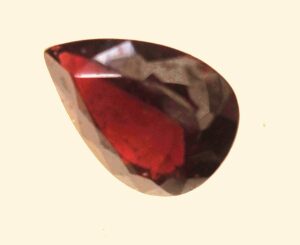


Ants Go Mining
It may sound strange, but ant hill garnet is actually mined by ants on the state’s Navajo Reservation. Also known as Arizona ruby, chrome pyrope and pyrope, there’s no set production for these gems since ants aren’t exactly reliable employees. These small, shimmering, bright red stones are beautiful and made even more fascinating by their provenance.
First discovered in the 1500s by the Navajo and Hopi people, the tiny gems rarely weigh over a carat but can be faceted to be set in jewelry. When ants are repairing or digging their ant hills, the garnets they find in their way are pushed up and out of the hill where they spill down the sides and can accumulate for humans to find and collect.
Because these gems are collected on private lands — and mined at the whim of the ant population — the only way to secure an ant hill garnet is through a professional gem dealer or jeweler.

